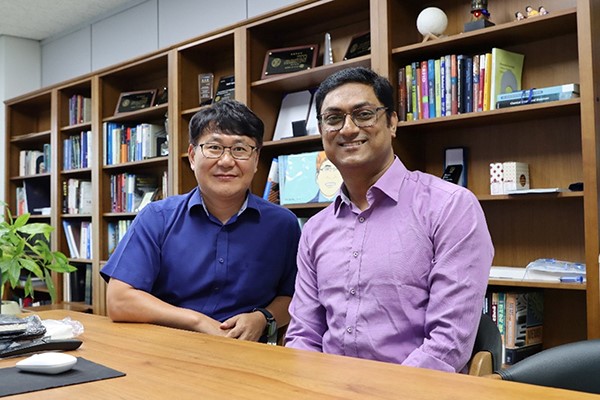Prof. Jae-Young Park and His Research Team Develop Multi-Sensor Patch for Chronic Disease Managemen
- admin
- 2024-10-15
- 149
Prof. Jae-Young Park (Department of Electronic Engineering) and His Research Team Develop Multi-Sensor Patch for Chronic Disease Management
·
Professor Jae-Young Park (Department
of Electronic Engineering) and His Research Team Develop Multi-Sensor Patch for
Chronic Disease Management
- Development of a multi-sensor patch based on
laser-carbonized graphene fusion electrodes containing core-shell hybrid
nanoporous carbon (f-HNPC) -
- Real-time monitoring of glucose, uric acid,
potassium, and ECG for remote management and digital therapeutics of chronic
diseases and metabolic syndrome -
- Research published in Advanced Functional Materials
(IF: 18.5), a top journal from Wiley -
Professor Jae-Young Park and his research team from
the Department of Electronic Engineering have successfully developed a
multi-sensor patch that can monitor real-time signals such as ECG, glucose,
uric acid, and potassium from the skin and sweat. The patch is based on
graphene fusion electrodes developed using laser carbonization, combined with
core-shell hybrid nanoporous carbon (f-HNPC), known for its outstanding
electrical, mechanical, and chemical properties. This high-performance patch is
expected to play a significant role in remote management and digital
therapeutics for chronic diseases and metabolic syndrome.

Given the growing interest in metabolic syndrome and
chronic disease management due to Westernized diets and aging populations,
wearable smart medical and healthcare systems that allow real-time monitoring
of biosignals have become increasingly essential. Research into sensor
technology capable of non-invasively monitoring chemical biosignals (such as
glucose and pH levels) and physiological signals (such as ECG, EMG, and EEG) is
actively being pursued worldwide. Particularly, sensor technology for measuring
and real-time monitoring of glucose in bodily fluids such as tears, sweat, and
interstitial fluid (ISF) is the subject of extensive research. However, most of
the patch sensor research reported so far focuses on measuring either chemical
biosignals or physiological signals, which limits their application in
next-generation smart healthcare and disease diagnosis systems that require the
monitoring of multiple and complex biosignals.
The research team synthesized a
hybrid (core-shell) structure to combine the large surface area of Zn-NPC
(derived from ZIF-8) with the high graphite-like electrical conductivity of
Co-NPC (derived from ZIF-67), resulting in the development of hybrid nanoporous
carbon (Co/Zn-NPC) with excellent electrical conductivity and an ultra-high
surface area. Co and Zn metal species were chemically etched from Co/Zn-NPC,
resulting in the formation of core-shell nanoporous carbon (CS-NPC) with a high
surface area and mesopores created by the pore generation process. Additionally,
the metal-organic framework (MOF)-based nanoporous carbon material was
functionalized with hydroxyl groups, an effective approach to enhancing the
sensitivity, selectivity, and biocompatibility of electrochemical sensors. Hydroxyl
groups provide active sites for the attachment of biomolecules or chemical
receptors that specifically interact with target analytes, thereby improving
the sensor's selectivity and sensitivity. Considering that surface
functionalization with hydroxyl (-OH) groups can be applied to accessible pore
structures, KOH activation technology is seen as a promising approach for
efficiently using nanoporous carbon (NPC) as a transport layer in sensor
applications.
The research team successfully
developed a flexible multi-sensor patch by coating core-shell nanoporous carbon
onto graphene electrodes produced using laser carbonization technology. The
patch integrates an electrochemical sensor for measuring glucose, uric acid,
and potassium from sweat, along with a dry-based ECG sensor for monitoring
heart activity from the skin. Through high-temperature calcination and KOH
activation, the f-HNPC nanoporous material was synthesized from core-shell
ZIF-8@ZIF-67 MOF crystals, and the KOH activation process was then used to
functionalize the hybrid nanoporous carbon (HNPC) with hydroxyl (-OH) groups.
The introduction of -OH groups facilitates the easy departure of fluoride ions
(F?) while accommodating OH? ions into the hexagonal graphite carbon ring structure. The developed
multi-sensor patch was attached to the chest, enabling real-time monitoring and
measurement of ECG, as well as glucose, uric acid, and potassium levels from
sweat. The synthesized f-HNPC-modified electrode significantly increased the
electrochemical surface area and electrocatalytic activity, enabling sensitive
and selective detection of sweat biomarkers, including glucose (103 ?A mM?¹ cm?²) and uric acid (184 ?A mM?¹ cm?²). It also provided a very wide
detection range for glucose, up to 41.5 mM. Additionally, the Nafion-coated f-HNPC-based
ISE exhibited a highly stable response with a Nernstian response very close to
59.49 mV/decade, while the ECG sensor demonstrated high-quality ECG signals
with a high SNR value of 23.63 dB. The multisensor patch developed in this study is expected
to be widely utilized in the smart management and digital treatment of chronic
diseases and metabolic syndrome through the construction of a u-healthcare
database and big data analysis, serving as a key technology for wearable
medical and healthcare platforms.
Meanwhile, this study was supported by the Ministry of Trade, Industry and Energy through the Korea Institute for Advancement of Technology (P0020967, 2024 Industrial Innovation Talent Growth Support Program), the Korea Planning & Evaluation Institute of Industrial Technology’s Industrial Technology Innovation Program (RS-2022-00154983, Development of a Self-Powered Sensor Platform for Low-Power Sensors and Actuators), and the 2023 Kwangwoon University Researcher Support Program. The research results were published in Advanced Functional Materials (IF: 18.5), a leading journal for functional materials and devices by Wiley.
https://onlinelibrary.wiley.com/doi/full/10.1002/adfm.202405651